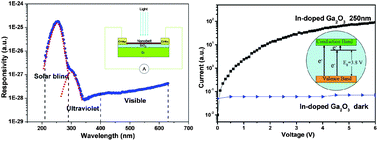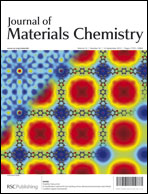Doping is an efficient way to tune the electrical and photoelectrical performances of one-dimensional semiconductors which have potential application as active materials in high performance nanoscale devices. Ga2O3 is one the most promising 1D semiconducting systems. However, controlled doping of Ga2O3 toward higher photoelectrical performances in Ga2O3-based photodetectors remains problematic. Herein high-quality In-doped Ga2O3 nanobelts are fabricated through a facile and effective thermal evaporation process. Their morphology and structure are systematically characterized. Indium has successfully been doped into the Ga2O3 nanobelts based on the data obtained. The In-doped Ga2O3 nanobelt-based photodetector has shown a higher sensitivity (9.99 × 104%), responsivity (5.47 × 102 A W−1), quantum efficiency (2.72 × 105%) and less rise/decay time (1/0.6 s), i.e. much better figures compared with not only the undoped Ga2O3 nanobelt/film but also other reported doped photodetectors. In addition, the above photodetector has a wider range photoresponse. In doping has led to significant improvements in the values of key parameters of the Ga2O3-based photodetector, beneficial for the fabrication of high-performance photodetectors.

You have access to this article
 Please wait while we load your content...
Something went wrong. Try again?
Please wait while we load your content...
Something went wrong. Try again?


 Please wait while we load your content...
Please wait while we load your content...